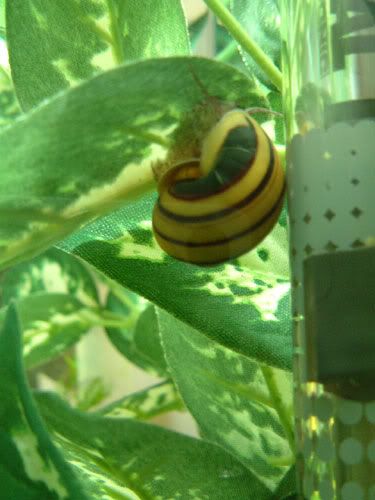catxx
Fish Gatherer
Common Name: Spixi Apple Snail, Zebra Apple Snail
Scientific Name Asolene Spixi
Family: Asolene
Origin: rivers, ditches, canals and lakes of South America, mainly Brazil
Maximum Size: 1" in diameter
Minimum Tank Size: 2.5 US gallons per snail
Life Span: unsure, similar to apple snails, 1-3 years
Care: Very similar to apple snails, easy beasts to care for. A well oxygenated tank with lots of hidey holes. They like to bury themselves in substrate, so a fine smooth gravel substrate or sand is perfect.
Preferred Temperature: 24-26 degrees celsius
Preferred PH: 7-8, any less than 7 and their shells will corrode
Feeding: all veges (cucumber, courgette etc), soft aquatic plants (mine is quite partial to vallis ), soft algae and sinking plec wafers
), soft algae and sinking plec wafers
Breeding: They are the same as regular apple snails in that they need to be in a male/female pair to breed. The eggs are deposited below the water surface (aquatic) on objects or vegetation and are embedded in a gelatinous mass.
Notes: Very pretty snails. From my experience be wary of exposed heaters these aren't the brightest of snails. I had one sit on it, the heater turned on, the snail died. I now have another in a tank with an enclosed heater he can't get to!
They also move slower than apple snails, and when they move they hold their shells up quite high which is amusing to watch!
This is the one that bbq'd himself! He was full-grown. I don't have a picture of the current one I have.

Scientific Name Asolene Spixi
Family: Asolene
Origin: rivers, ditches, canals and lakes of South America, mainly Brazil
Maximum Size: 1" in diameter
Minimum Tank Size: 2.5 US gallons per snail
Life Span: unsure, similar to apple snails, 1-3 years
Care: Very similar to apple snails, easy beasts to care for. A well oxygenated tank with lots of hidey holes. They like to bury themselves in substrate, so a fine smooth gravel substrate or sand is perfect.
Preferred Temperature: 24-26 degrees celsius
Preferred PH: 7-8, any less than 7 and their shells will corrode
Feeding: all veges (cucumber, courgette etc), soft aquatic plants (mine is quite partial to vallis
 ), soft algae and sinking plec wafers
), soft algae and sinking plec wafersBreeding: They are the same as regular apple snails in that they need to be in a male/female pair to breed. The eggs are deposited below the water surface (aquatic) on objects or vegetation and are embedded in a gelatinous mass.
Notes: Very pretty snails. From my experience be wary of exposed heaters these aren't the brightest of snails. I had one sit on it, the heater turned on, the snail died. I now have another in a tank with an enclosed heater he can't get to!
They also move slower than apple snails, and when they move they hold their shells up quite high which is amusing to watch!
This is the one that bbq'd himself! He was full-grown. I don't have a picture of the current one I have.

